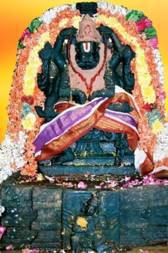1. Ahobila Narasimha shrine:

The temple, situated on the upper Ahobilam, at a distance of eight kilometres from the lower Ahobilam, is the main temple and the earliest of all the nine shrines. The Lord in main altar appears in his fierce aspect. Hence He is called Ugra Narasimha. He is the presiding Deity of the temple and is also known as Ahobilam Narsimha. This Narsimha deity is self manifested (svayambhu).
2. BhargavaNarsimha shrine:
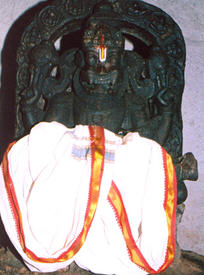
BhargavaNarsimha shrine is situated on the hill at a distance of two kilometres from the lower Ahobilam, near the sacred pond, known as Bhargava tirtham. It is the site where Bhargava Rama performed his penance. Hence the Lord of the temple is known as Bhargava Narsimha.
The entire distance is to be covered on foot. At some distance down a deep incline, we come to a very calm place where we find a beautiful pond of cool, fresh and crystal clear water surrounded by ever green thick shrubs and tall trees. The pond is also called Akshaya Tirtha. At a few yards away from this pond, we reach the Bhargava shrine by climbing up few steps.
The Deity installed in the Garbhagriha is four-handed form, upper two hands holding the Chakra and Sankha, the lower two hands (as shown) tearing the intestines of Hiranyakasipu. Hiranyakasipu is shown with a sword in his right hand. Prahlad is seen on the right in the Sthanaka posture with Anjali hasta.
3. Yogananda Narasimha shrine:
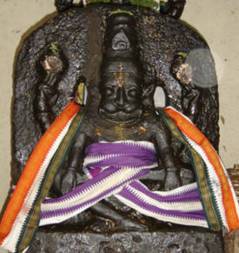
This shrine is at a distance of two kms to the south-east of Lower Ahobilam. The popular legend is that after killing Hiranyakasipu, Lord Narasimha taught Prahalad several yogic postures. Therefore,the Lord in this posture is called Yogananda Narasimha. It is connected by a good road. This shrine is a plain stone structure with a square Garbhagriha and ardhamandapa. Lord is about two feet eight inch high who is seated on a Garuda pedestal of one feet two inch high. The Lord is seated in the yogic posture of their legs being crossed and tied with a Yogapatta. The Deity is four handed and holds Chakra in the upper right hand and Sankha in the upper left hand. The other two hands rest on the knees.
4. Chatravata Narasimha:
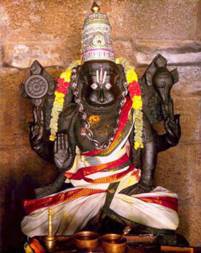
The shrine of Chatravata is about four kilometres away from the lower Ahobilam, on the same motorable road leading to Yogananda. But we have to walk about a furlong on a rough track from the road to reach this shrine. The temple is small and is under the shade of an umbrella-like banyan tree. Hence the Deity here is called Chatravata Narsimha.
The Deity is seated in the padmasana pose on a low padmapitha. The two upper hands hold the Chakra and Sankha.The lower right hand is in the abhaya posture, while the lower left hand is a Katihasta, placed on the waist and the left thigh. It is said that the two Gandharvas named Haha and Huhu came from Meruparvata and entertained this Narasimha with their melodious singing, where upon, the Lord blessed them to become first rate singers in all the three worlds. Even now devotees who visit this shrine sing melodiously before the deity to give him pleasure.
5. Krodha or Varaha Narasimha:
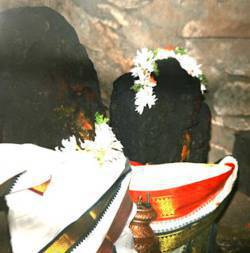
The shrine of Varaha Narasimha is one km away the main temple of Ahobila Narasimha of the upper Ahobilam.Walking along side the Bhavanasini river east-wards and Kalakshepa Mandapa,we arrive at the cave shrine of Krodha(Varaha).Surrounded by attractive natural scenery all around, The lofty mountains over-grown with tall trees are awe inspiring.In the narrow valley between Vedari and Garudadadri,the silver stream of Bhavanasini glides on beautifully.
In this cave shrine, there are two deities, one of lakshmi-Narasimha and another Sthanaka figure of Varaha Narasimha with his consort, goddess Bhudevi.The goddess is shown as embracing the ‘snout’ portion of the lord, just as she did while being raised by him up from the ocean waters after piercing Hiranyaksha with his tusks and then slaying him.Varaha stands in a tribhangaposture with only two hands,the head of the boar and the tail of the lion on a human torso.
6. Karanja or Saranga Narasimha:
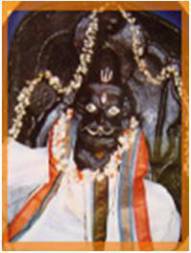
This shrine is situated at a distance of one kilometre from the upper Ahobilam and one furlong away from the road leading to lower Ahobilam. The Bhavanasini river glides at the left of the road. The shrine is under a karanja tree which accounts for the name Karanja Narasimha.
The Deity of the Lord appears to be seated in meditation, with a hooded cobra over the head. The upper right hand holds a Chakra and upper left hand has Sarangaor bow. The lower hands are in dhyaana mudra.
7. Malola Narasimha:
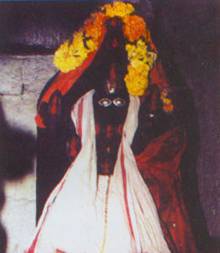
Malola shrine is situated nearly two kilometres from the main temple of the upper Ahobilam. The Deity here appears in ‘Soumya’ (peaceful) form. As Narasimha is seen with his consort, Lakshmi, He is known as Malola Narasimha. The word ‘Malola’ means beloved of Lakshmi (ma is Lakshmi, Lola is beloved).
The shrine is on a level surface of a peak of the Vedadri Mountain. This place is also called Markonda Lakshmi Kshetra.
The God is seen seated here in Sukhasana posture with his left leg folded while the right leg is shown dangling at an angle. The goddess is shown seated on the left thigh of the Lord with Kataka and Parisaritya vamahasta. The feet of the goddess rest on padma which appears to have sprouted from the earth. The Lord’s two upper hands hold Chakra and Sankha, his lower right hand is in abhaya pose and the lower left hand is shown embracing his consort.
8. Jwala Narasimha:
The temple of Jwala Narasimha, lies higher up the Malola temple, on a hill called Achalachaya Meru. This is about four kilometres from the upper Ahobilam temple. This place is said to be actual spot where the ferocity or anger of the Lord reached its acme when he tore Hiranyakasipu. It is somewhat difficult to reach this place as we have to pass through a narrow passage made by cutting and chiseling the rocks of the peak on one side, while to the other side of this passage there is a very deep valley.One has to walk very carefully. It is told that the spot where Jwala Narasimha is sitting with Hiranyakasipu on his lap is the threshold of the main entrance door of the spacious palace of Hiranyakasipu. Cleaving one of the pillars of the demon’s palace, Narasimha manifested himself. The part of this pillar standing erect has the shape of a lofty hill.
It is generally believed that after slaying Hiranyakasipu, Narasimha looked very frightful. To pacify him, Indra and other gods poured Suraganga water (celestial Ganges) on his head which flowed down as a stream into the nearby valley and the later into the river called Bhavanasini. In front of this shrine, there is a small pond bellow a fully open cave. The water of this pond is very reddish. The color of this water is said to be due to Narasimha’s washing his hand here after tearing the abdomen of Hiranyakasipu.
The shrine appears to be a natural cave. There are three deities in the shrine, Ashtabuja Narasimha, Chaturbhuji Narasimha and Narasimha chasing Hiranyakasipu.
(a) Ashtabhuja Narasimha:
The main deity seated at the centre is with eight arms. He is seated on a Garudapitha and a small image of Prahlada is placed to the left of Narasimha, standing with folded hands.
The sculpture suggests massive energy and vigorous action. The first pair of hands catches hold of Hiranyakasipu’s crown and renders him motionless, while the other pair by tightly gripping the sword-carrying hand of Hiranyakasipu completely disarms and overpowers him. The second pair of hands is engaged in tearing open the entrails of the demon lying on the folded right leg of the God.The pair of hands holds Sankha and Chakra and the fourth pair holds the intestine of the demon in the shape of a garland.
(b). Chaturbhuja:
This figure is depicted in the standing posture coming out of the pillar(Stambhodbhava-murti). This is said to represent the Kevala Narasimha form. This is very rare form . It has 4 hands, the 2 upper hands holding chakra and sankha and the lower hands are depicted downwards as though He is tearing the demon. But peculiarly the demon is not depicted. Laxmi is seated to the right and Prahlada stands to the left .
The third figure depicts Narsimha as advancing towards Hiranyakasipu from the right, as the later is approaching in a defiant attitude, with his sword lifted up to strike. Narsimha is made to take hold of the body of Hiranyakasipu so as to overpower him. Moreover, the right hand of Narsimha is held up as if he is going to deal a blow to the enemy with the open palm of the hand.
9. Pavana Narasimha:

Pavana Narasimha shrine is situated on the bank of the river Pavani and it is about six kilometres from the upper Ahobilam temple. One has to walk the entire distance from upper Ahobilam southwards, a hilly forest track. This shrine is in the middle of a dense forest.
The shrine is a small rectangular building with a Garudastambha in front. The presence of Garudastambha suggests that the shrine might have been in great prosperity and annual functions were being regularly conducted. There is another shrine, opposite to this, dedicated to Shiva.
At a distance of about a kilometre from this shrine, chenchus (tribal people) reside. They, even to this day, sing in their own language the momentous marriage of the Chenchu bride with Narsimha.
The main deity is actually a Lakshmi Narasimha deity, with four hands. The upper two hands carry Sankha and Chakra. The lower right hand is in abhaya pose, while the lower left hand is shown as embracing Lakshmi seated on His left thigh. The Lord is seated in Sukhasana posture on Adisesha with His left leg folded while the right leg bent at the knee. Dangling down over the head of Narsimha is found a seven-hooded snake (Adisesha) spread like an umbrella. Lakshmi is shown seated on the thigh of the Lord with right hand embracing God.
10. Prahlada Varada Narsimha Temple
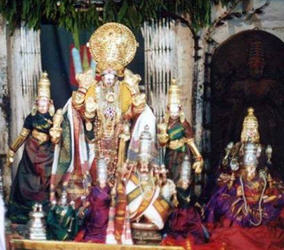
Though this temple is not one of the Nava Narasimha temples, but is very closely connected with this kshetra and hence popularly visited first. In this temple, Lord is seated facing Prahlada. In the altar, one can see the utsav vigrahas of Jvala Narasimha, Pavan Narasimha and upper Ahobilam temple.
